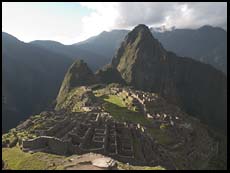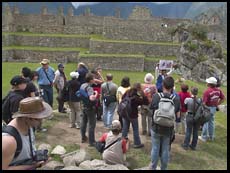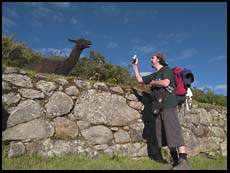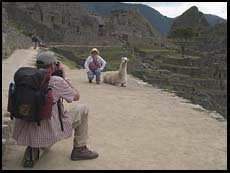




When traveling, do you wait for fellow tourists to get out of the way before taking a picture? Why? If you're trying to communicate the experience of being in a place, aren't those mobs of tourists part of the experience? The more despoiled by tourism a place has become, the more important it is to capture a big tour group clogging a passageway.
Let's consider this from another perspective. Suppose that you are offered a choice of viewing some photos of the Eiffel Tower that were taken in the 1930s. Would you rather see a photo containing tourists of the period or a photo of the tower by itself? The Eiffel Tower hasn't changed in any interesting ways since the 1930s, but tourists have. A photo captured at 6 am showing a deserted site before all of the other tourists showed up might have more value for a postcard or calendar, but it is a less interesting record of the experience people in the early 21st Century had at that site.
In each section below, we will look at a typical quality photograph of a heavily visited site. The photograph will accurately depict the site, but show no tourists. That photo will be followed by between 1 and 5 photos of the same place, but showing tourists doing the things that tourists do.
From Machu Picchu: The first image is not that different from what National Geographic might have run in April 1913. The average visitor today, however, does not experience the solitude that Hiram Bingham and his Yale pals did in 1911.
From Barcelona: Gaudi's garden dragon is a great work of art, but a picture of the dragon alone, taken at high noon, won't win any prizes.
From Jack's Camp in Botswana: Any fool with a 70-200/2.8 lens can get a great portrait of a Meerkat. What is more interesting is showing how accustomed to humans some Meerkats are, which is, of course, why any fool with a short telephoto lens can get a great portrait of a Meerkat...
From Victoria Falls: On a short visit it is almost impossible to create a competitive photograph of Victoria Falls. The best photos of the falls were taken during just the right water flow conditions (some spray but not too much) when perfect weather and great light aligned. The trails, however, are filled with people trying to protect themselves from the spray, take photos, and protect their cameras from getting soaked.
From Namibia: The ancient Namib desert is one of the most sparsely populated places on the planet. The first image, therefore, is not unrepresentative of what a tourist renting a camper truck might experience. However, even in this authentically unspoiled place, a picture or two with fellow tourists adds humor and highlights the puny scale of things human.
From the Hearst Castle in Central Coast of California: From the first photo, you might conclude that a visit to this Newspaper magnate's retreat would evoke thoughts of the Gilded Age. The subsequent photos demonstrate that the reality is being herded onto a crowded bus and being pushed through the house in a mob of the decidedly unfashionable.
From Galapagos: If you want to show that the animals aren't afraid of humans, one of the unique properties of these islands, you need to include some people in your photos.
From the Peruvian Amazon: The Amazon is indeed vast and much of it is trackless. However, it is impractical for the average tourist to visit the Amazon except in a group and/or staying close to a lodge. A photo showing the tourists is a better record of the Amazon leisure experience than a photo showing the wilderness.
From the Grand Canyon: One of the most heavily photographed places in the world. You're unlikely to be fortunate enough to be in the right place during the right weather to capture a definitive image. You might be the only one to capture this particular corner of the canyon with a group in contemporary outdoor garb.
From New Mexico: The Anasazi ruins inspire wonder. White people attempting to commune with the spirits of the Anasazi inspire even more wonder.
From Turkey: Volcanic tuff and erosion create fantastic land forms in Cappadocia. An Asian tour group adds interest to almost any scene, however.
From the Vatican: Remember that a tripod, or leaning against a wall, and a slow shutter speed can reduce tourists on the move to an abstraction.
From Rome: Note the heavy winter clothing; this is the off season.
From Venice: A great place to explore the human desire to be photographed in front of a famous site.
From Paris: Art in the City of Lights is interesting, but always look for photographs of people responding to the art. Nobody needs a straight-ahead photo of the Mona Lisa.
From India: There is nothing remarkable about being mobbed by people in India. However, it is very seldom that one is mobbed by fellow foreign tourists. In a country of more than 1 billion people, the 3 million annual foreign tourists, each of whom stays less than one month, are scarcely apparent. Consequently, if you do find yourself in a situation where you see a big tour group, take a moment to capture it. Either you are recording the growth of the Indian middle class, if the tour group is domestic, or an unusual gathering of foreigners, if the tour group is from overseas.
From Travels with Samantha, Chapter IX: Denali National Park seems like a vast lonely wilderness. In fact, the National Park Service packs tourists into schoolbuses for 12-hour rides down a dirt road. There is nothing natural, quiet, or solitary about the experience unless you get a backcountry permit and wander off on a multi-day hike (don't forget your mosquito headnet).
From Travels with Samantha, Chapter X: Looking at one of the ubiquitous photographs of a Katmai National Park bear, one might wonder just how rugged and wild the experience of being a nature photographer there is. The second photo, of a bunch of folks standing on a National Park Service wooden deck, should answer the question. If you can bring only one lens, make it the 300/2.8 and a teleconverter. If you can bring two, though, add a wide-to-telephoto zoom for recording the antics of the other humans on the platforms.
From San Miguel de Allende, the gringo capital of Mexico: an image of authentically dressed-up-for-the-tourists locals might be interesting to some third grade geography students; an image of those locals interacting with tourists is your best chance to make an adult viewer smile.
"If your pictures aren't good enough, you aren't close enough." That old photojournalism bromide applies here. To give viewers the feeling that they are hemmed in by a crowd, you'll need to be close to a few other people. If you're close to some people, the only way to show the rest of the crowd is with a wide angle lens. Most of the best photos in this article were taken between 16mm and 35mm on a full frame digital SLR. An ideal lens on a full-frame camera therefore would be a 16-35mm zoom; on a small sensor (APS) camera, the equivalent would be 10-22mm.
Oftentimes the tourists are trying to stay in the shade while the monument is lit by direct sun. This creates a tremendous amount of contrast, maybe not too much for a camera RAW file to represent, but certainly too much for a JPEG or any printing technology. A powerful on-camera flash can brighten the foreground and help reduce the inherent contrast in the image, saving a lot of digital post-processing work.
Can you take these kinds of images with a mobile phone or point and shoot camera? Sure! The humor in the photo is more important than image quality. If choosing a point and shoot camera for this application, try to get one with a lens that can zoom out as wide as possible, at least a 28mm equivalent and preferably 24mm. Point and shoot cameras never offer the wide perspectives that are available on digital SLRs with accessory lenses, so you can definitely improve your images in this genre by carrying a digital SLR.
The world has grown substantially wealthier in the years since standard tourism sites were established and photographed. The Boeing 747 made round-the-world air travel cheap enough for middle class people everywhere. Massive tour groups need not be your only subject when visiting a beautiful or intriguing place, but it is not necessarily a good idea to ignore them, work around them, and pretend that mass tourism does not exist.
Fifty years from now, people will look at your photos and they might be impressed by the composition and lighting. Most likely, however, the first thing that will jump out at them are the hairstyles, the pay phones, the clunky mobile phones that people hold up to their ears, the ridiculous laptop computers, the enormous cameras, the hideous clothing. A fat tourist might seem like an obstacle to creating a photo with impact, but in decades to come, he or she might become the most interesting part of the photo.
Text and pictures copyright 1995-2008 Philip Greenspun